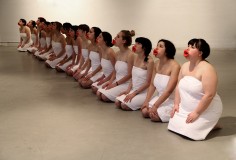chun hua catherine dong
the double
source: chunhuacatherinedongwordpress
45 minutes at place-des-art, Montreal, Feb 7, 2014, Photo by Parham Yazdy
Performed by Laurence Eulalle, Stephanie Wu, Maggy Flynn, Veronique Morier, Mary Williamson, Brittney Gering, Bailey Eng, Ekaterina Kukharchuk, Lucy Fandel, Camille Brisson, Liliana Argumedo, Mira Fister-Tadic, Wing Sze Tsang-Hy, Alida Esmail, Natalie Montalvo.
Sixteen females wear red mouthpieces and white bath towels, standing in a row and facing the same direction. They repeat four still gestures: standing, kneeing, sitting, and lying on the floor. The performers hold each gesture for five minutes and then move to another gesture.
The gestures in the performance are inspired by gargoyle, a legendary stone-carved grotesque with a spout that normally is designed to convey water from a roof. Mouth serves as the opening for food intake and in the articulation of sound and speech. However, when performers wear the mouthpieces, or when women’s mouth is forced to open, the mouth loses its function. In fact, it silences and disables the women because they are unable to talk when their mouths are widely pulled open. This performance explores another side of the unseen and unspoken—the vulnerability, struggle, shame, and suffering that we are uneasy to share and expose.
.
.
.
.
.
.
.
source: chunhuacatherinedongwordpress
Chun Hua Catherine Dong is a Chinese-born artist working with performance art, photography, and video. She received a B.F.A from Emily Carr University Art & Design and a M.F.A. from Concordia University. She has been invited to participate in multiple international performance art festivals and exhibitions in North American, Europe, and Asian. Among many other awards, she is the recipient of the Franklin Furnace Award for performance art 2014.
ARTIST STATEMENT
Life itself is a performance. Dong considers performance as an attitude rather than a medium, an ideology rather than a style, a situation rather than an action. She is interested in blurring boundaries between personal and political, between private and public, between performance and everyday practice. Body is political. as part of her interest in identity politics and postmodern feminism, she utilizes body as a disturbance in order to explore ruptures in society.
Initially working in painting and drawing, she has been using performance art, photography, and video since 2009. She has established her body as a visual territory, and a primary material that she uses in her artwork to activate social commentary on immigration, race and gender. Through encapsulating these global issues in microcosm or magnifying personal predicaments until they become universally visible, she presents the body as a defined and experienced reality, and locate herself at the nexus of author, artwork and audience.
Her work mainly deals with cultural intersections brought on by globalization, asking what it means to be a citizen of the world today. It is relevant to open dialogues about “deterritorialization” and “disessentialization” in culture and how to transform socio-political landscapes through gestures. The gestures in her work symbolic and metaphoric: at times subversive, meditative, subtle and/or humorous. But they mostly express her desire to transform the everyday political life into art, striving to install a model for social transformation that possibly could create a new way to look at utopia.
In her earlier works, the body represented an ideological confrontation or political alienation. She used silence as a method of protest to call attention to issues in the context of multicultural society, giving voice to those silenced or to raise visibility to those made invisible by dominant ideologies. In her newer works, she views the body as a bridge connecting east and west, past and present, creating a new version of hybridity and striving to transcend and mend.
She also uses body gestures as a form of investigation and representation in her interest in ethnographic research to explore cultural phenomena in order to understand social life of humans. Through focusing on the interaction between politics, aesthetics, and memory, she examines relationship between citizens and the place they have lived, between what they have lost and what they have gained in the rapidly changing city.
.
.
.
.
.
.
.
source: facebook
Le travail de Chun Hua Catherine Dong aborde les manières d’approcher la déterritorialisation et la désessentialisation dans notre monde où les cultures sont prises pour acquises de même que la façon de traiter et de transformer les paysages sociaux et politiques à travers les actes du corps. L’artiste examine les multiples facettes des combats d’une femme liée à une identité, un genre et une sexualité pour révéler la lutte et le conflit enracinés dans les individus et les groupes ethniques.
Les oeuvres de Chun Hua Catherine Dong manifestent une réalité construite où les frontières entre privé et public, sujet et objet, art et vie, sont brouillées. Elles sont l’expression profondément ressentie d’une réalité subjective explorée par les moyens du langage, du symbolisme et du geste. Le travail proposé transcende l’expérience personnelle et la réalité. Memento mori rappelant le passage inexorable du temps, il incarne le désir mélancolique d’un irrécupérable passé.
Chun Hua Catherine Dong est une artiste de la performance d’origine chinoise et résidant au Canada. Elle a été invitée à performer sur la scène internationale, notamment au 4th International Festival and Conference for Live Art and Performance Studies en Finlande et au International Multimedia Art Festival à Burma. Son travail de performance apparaît dans le palmarès des neuf meilleurs projets d’art politique de 2010 du Art and Threat Magazine, parmi des artistes reconnus internationalement tels Rebecca Belmore et Wafaa Bilal. Sa recherche actuelle Performance Ethnography: a Method of Inquiry in Research of Visualization, est soutenue par le Conseil de recherches en sciences humaines du Canada, le Département des arts de l’Université Concordia ainsi que le Conseil des arts de la Colombie-Britannique.


